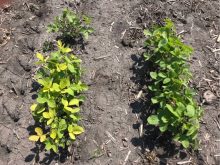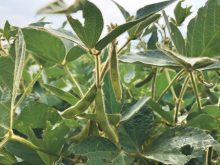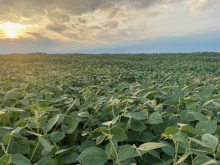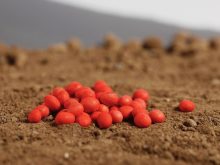If you plant soybeans in Manitoba, you may have wondered about seeding in late spring, ideal seeding depth, fungicide efficacy and other facets of soybean production in recent years.
Kristen MacMillan, a research agronomist for the University of Manitoba’s department of plant science, has the answers to several important soybean production questions, on which soybean growers in the province can base management decisions.
Recent soybean research sheds light on late-season suitability for seeding as well as yield comparisons for various seeding windows. Additionally, ideal seeding depths for soybeans, yield responses to fungicide and the efficiency of various intercrop combinations involving soybeans and relay cropping in winter cereals were a few of the topics included in the studies. MacMillan presented these findings during a presentation for farmers at a virtual Ag in Motion session held by Glacier FarmMedia last year.
Read Also

Claas brings 1000 Series SP forage harvesters to Canada
In mid-August, Claas unveiled its new line of Jaguar forage harvesters at an event in Visalia, California, deep in the heart of that state’s dairy region.
She also placed a disclaimer on the research findings, however, by stressing the importance of environment in soybean production and why it’s a critical factor to consider when making management adjustments.
“What I want you to understand is that while management decisions are important and each incremental change adds up — particularly seeding depth — don’t forget the importance of environment,” she says.
“Regardless of whether we’re choosing best management practices or not, at the end of the day, soybeans and every type of crop require a certain environment, whether that’s soil or weather conditions. Soybeans particularly come down to moisture availability.”
June seeding possible, but worth it?
Some Manitoba producers have been asking if soybeans are suitable for seeding in late May or June. The U of M conducted a three-year study on plots in Arborg (about 100 kilometres north of Winnipeg), Portage la Prairie (about 85 kilometres west of Winnipeg) and Morden (southern Manitoba near the U.S. border) to find out if 80 per cent yield could be maintained with seeding in June.
The bottom line is it depends on where in Manitoba you farm, says MacMillan.
“In Arborg, as seeding is delayed from late May through late June, we lost up to 35 per cent yield potential. That occurred in two out of three years.”
The other locations proved to be more realistic venues for June seeding — at least in the first week of the month.
“In Portage we were able to maintain 80 per cent yield potential. We lost yield one year but were still able to maintain 80 per cent yield potential. That’s compared with Morden, where from late May through mid- to late June, we were able to maintain similar yield potential.
“In terms of late-seeding options for those areas, yield potential tells us ‘No’ in Arborg but ‘Yes’ in Portage and Morden.”

A big question, however, is whether late seeding presents any clear advantages, particularly as June wears on.
“As seeding was delayed, days to maturity either stayed the same or were reduced slightly. So even though we can maintain yield potential (by seeding) in mid-June, the soybeans weren’t maturing past the typical crop state.”
Still, MacMillan says there are likely to be changes to seeding deadlines for Soybean Insurance Area One (where Morden is located) and Area Two (Portage la Prairie).
“They will likely be through the first week of June but likely no later than that due to the maturity risk. And current seeding deadlines are certainly appropriate for the shorter-season, cooler-growing areas like Arborg.”
Seeding windows flexible
Is there a recommended seeding date for Manitoba overall? MacMillan’s research looked at four seeding windows ranging from very early (April 28 to May 6) to late (May 31 to June 4). The first three windows — comprising April 28 to May 24 — were all comparable in terms of yield, although there’s generally greater risk in the first window due to spring frost and potential low temperatures.
Yield maximization occurred most frequently in the second week of May, but it’s key for growers to be strategic.
“Specific regional and soil decisions on seeding date should be made by considering soil temperature, weather forecast and last spring’s frost date,” says MacMillan.
“Avoid cold soil and cold rain for the first 24 to 48 hours. I know we typically use 10 C as a rule of thumb, which might be a little bit conservative. The United States is pointing towards something more like seven degrees. We may be okay in the seven to 10 C zone as long as the forecast is good.”
The main take-away, says MacMillan, is seeding windows are flexible.
“I think we can put to the side the old adage of waiting for the May long weekend. It’s really about seeding in the first half of May and we’re starting to see that trend. A lot of soybeans are going into the ground at the end of May, but over the past five years it’s really moved towards May 11 to 20, which I like to see,” she says.
Half-inch or deeper seed depth recommended
What’s the ideal seeding depth for soybeans? That’s the question MacMillan sought to answer with a three-year study conducted on three plots of clay soil at Arborg and another three plots of lighter loam soil at Carman. Precipitation was lower than normal — typically between 40 to 70 per cent of normal in May and June — throughout the three years of the study (2017 to 2019).
The seeding depths ranged from a quarter of an inch to 2.25 inches. A half-inch or deeper was sufficient to achieve the recommended plant stand of 140,000 to 160,000 plants per acre, says MacMillan.
“There was a slight reduction with deep seeding but still well within an acceptable range,” she says.

What did seeding depth mean for yield? “On average, we saw 20 per cent yield reduction with shallow seeding and a 10 per cent yield reduction with deep seeding. Based on this yield response, the optimum depth for soybean is going to be anywhere from 0.75 inches to 1.75 inches. That will maintain yield between 90 and 100 per cent of maximum,” she says.
A compelling reason to be wary of seeding deeper than that is potential loss of cotyledons — the literal powerhouses in the plant that store energy and aid photosynthesis. Other symptoms of seeding at lower depths included hypocotyl swelling, general chlorosis and delayed establishment — all of which can play a role in yield reduction.
“The literature has shown that the loss of one or both cotyledons can reduce soybean yield,” says MacMillan.
No significant yield response with fungicides
Fungicide is not a “silver bullet” in soybean production, at least in Manitoba, says MacMillan. In fact, her research, conducted at Carman over three years, revealed no significant yield response to fungicide application regardless of timing or product.
“This is in line with the on-farm research the Manitoba Pulse and Soybean Growers have been doing over the past five years. In more than 60 on-farm trials there’s only been a response probability of 15 per cent.”
The reason, says MacMillan, is the majority of the most commonly diagnosed soybean diseases in Manitoba are foliar leaf diseases. These aren’t the “yield robber” soil-borne diseases like sudden death syndrome — which exist in the province at low levels — tend to be.
“The take-home here is we really need to be focusing on watching out for these yield-robbing diseases and they’re going to require more complex management strategies than a fungicide application.”
Intercropping hot, relay cropping not
The University of Manitoba has been looking at various intercrop combinations involving soybeans from an efficiency and revenue perspective. Of these, peas and soybeans have proven the most promising at $600 per acre, although flax-soybean and oat-soybean have also shown strong results at more than $400 and about $380 per acre, respectively.
Relay cropping, which is a concept that has been taking off in the United States in recent years, has not proven as successful. The cropping practice involves planting soybeans in the spring between rows of winter wheat. That year, both crops would be harvested.
“We’ve been testing soybean relay cropping in winter cereals at Carman since 2017,” says MacMillan. “We’ve looked at various row spacing and seeding rate combinations and, in short, we have not found a system that is showing a lot of promise at this point.”
The researchers have been able to achieve 50 to 75 per cent of the cereal crop in soybean pairings but the soybeans themselves have typically been suppressed. “That’s where a lot of the cost is coming from. It’s essentially like seeding a second crop. We need more work on this.”
















